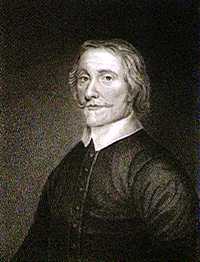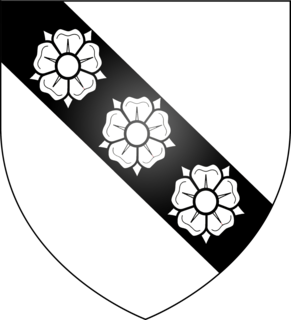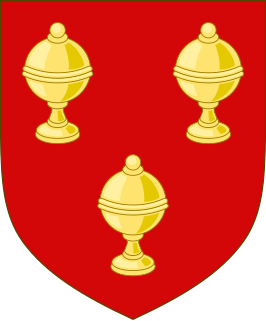Related Research Articles

The title Duke of Abercorn is a title in the Peerage of Ireland. It was created in 1868 and bestowed upon James Hamilton, 2nd Marquess of Abercorn. Although the Dukedom is in the Peerage of Ireland, it refers to Abercorn, West Lothian, and the Duke also bears four titles in Peerage of Scotland and two in the Peerage of Great Britain, and is one of only three peers who have titles in those three peerages. The Duke of Abercorn also claims the French title of Duke of Châtellerault, created in 1548.

Charles Blount, 1st Earl of Devonshire, KG was an English nobleman and soldier who served as Lord Deputy of Ireland under Queen Elizabeth I, and later as Lord Lieutenant of Ireland under King James I.

Earl of Devon was created several times in the English peerage, and was possessed first by the de Redvers family, and later by the Courtenay family. It is not to be confused with the title of Earl of Devonshire, held, together with the title Duke of Devonshire, by the Cavendish family of Chatsworth House, Derbyshire, although the letters patent for the creation of the latter peerages used the same Latin words, Comes Devon(iae). It was a re-invention, if not an actual continuation, of the pre-Conquest office of Ealdorman of Devon.

Earl of Coventry is a title that has been created twice in the Peerage of England. The first creation for the Villiers family was created in 1623 and took its name from the city of Coventry. It became extinct in 1687. A decade later, the second creation was for the Coventry family and is still extant.
The title of Viscount Mountjoy has been created three times, twice in the Peerage of Ireland and once in the Peerage of Great Britain. The creations in the Peerage of Ireland were made in 1683 and 1795, and became extinct in 1769 and 1829, respectively. The creation in the Peerage of Great Britain occurred in 1796, as a subsidiary title for the Marquess of Bute, to which title it is still attached.

Earl of Drogheda is a title in the Peerage of Ireland. It was created in 1661 for The 3rd Viscount Moore.

Viscount Valentia is a title in the Peerage of Ireland. It has been created twice. The first creation came in 1621 for Henry Power. A year later, his kinsman Sir Francis Annesley, 1st Baronet, was given a "reversionary grant" of the viscountcy, which stated that on Power's death Annesley would be created Viscount Valentia. Annesley, a member of an influential Anglo-Irish family which descended from Newport Pagnell in the County of Buckinghamshire, was a favourite of James I, who granted him land in Ireland, notably the fort of Mountnorris in County Armagh. He was knighted in 1616, created a baronet, of Newport Pagnell in the County of Buckingham, in the Baronetage of Ireland in 1620 and Baron Mountnorris, of Mountnorris in the County of Armagh, in 1628.

Baron Hunsdon is a title that has been created three times.
The title of Earl of Devonshire has been created twice in the Peerage of England, firstly in 1603 for the Blount family and then recreated in 1618 for the Cavendish family, in whose possession the earldom remains.

The peerage title Earl of Ormond and the related titles Duke of Ormonde and Marquess of Ormonde have a long and complex history. An earldom of Ormond has been created three times in the Peerage of Ireland.

Earl of Clanricarde is a title that has been created twice in the Peerage of Ireland, first in 1543 and again in 1800. The former creation became extinct in 1916 while the 1800 creation is extant and held by the Marquess of Sligo since 1916.

Viscount Fauconberg, of Henknowle in the Bishopric of Durham, was a title in the Peerage of England held by the head of the Belasyse family. This family descended from Sir Henry Belasyse, High Sheriff of Yorkshire from 1603 to 1604, who was created a Baronet, of Newborough in the County of York, in the Baronetage of England in 1611. His son, Sir Thomas, the second Baronet, was created Baron Fauconberg, of Yarm in the County of York, in the Peerage of England in 1627. In 1643 he was further honoured when he was made Viscount Fauconberg, of Henknowle in the Bishopric of Durham, also in the Peerage of England. He was succeeded by his grandson, Thomas, the second Viscount, the son of Henry Belasyse. Thomas was created Earl Fauconberg in the Peerage of England in 1689. He was childless and the earldom became extinct on his death in 1700. He was succeeded in the remaining titles by his nephew and namesake, Thomas, the third Viscount, the son of Sir Rowland Belasyse. The third Viscount was succeeded by his son, Thomas, the fourth Viscount, who in 1756 was created Earl Fauconberg, of Newborough in the County of York, in the Peerage of Great Britain. The Earl's son Thomas, the second Earl, had no sons and the earldom became extinct on his death in 1802. He was succeeded in the remaining titles by his second cousin Rowland Belasyse, the sixth Viscount, the grandson and namesake of Rowland Belasyse, younger brother of the third Viscount. The sixth Viscount was succeeded by his younger brother, Charles the seventh Viscount, on whose death in 1815 all the titles became extinct.
Earl of Sussex is a title that has been created several times in the Peerages of England, Great Britain, and the United Kingdom. The early Earls of Arundel were often also called Earls of Sussex.
The title of Earl of Blessington was created twice in the Peerage of Ireland, in 1745 and 1816. Both creations became extinct, in 1769 and 1829 respectively. The earldom was also spelt as Blesington.
Viscount Windsor is a title that has been created twice.

Earl of Newport, in the Isle of Wight, was a title in the Peerage of England. It was created in 1628 for Mountjoy Blount, 1st Baron Mountjoy, an illegitimate son of Charles Blount, 1st Earl of Devonshire. He had already been created Baron Mountjoy, of Mountjoy Fort in the County of Tyrone, in the Peerage of Ireland in 1618, and Baron Mountjoy, of Thurveston in the County of Derby, in the Peerage of England in 1627. The latter title was originally created with precedence ahead of those barons created between 20 May and 5 June 1627. This precedence was later revoked by the House of Lords. The first Earl's three surviving sons were "all idiots", and some confusion exists as to their names and dates of death. Parish registers indicate that the second Earl, named either George or Mountjoy, died at Newport House in London, and was buried at St Martin-in-the-Fields in March 1675; his brother Thomas, the third Earl, was buried at Weyhill in May 1675; and their youngest brother Henry was buried at Great Harrowden in September 1679. Upon his death, all of his father's titles became extinct.

Earl of Howth was a title in the Peerage of Ireland. It was created in 1767 for Thomas St Lawrence, 15th Baron Howth, who was elevated to Viscount St Lawrence at the same time, also in the Peerage of Ireland. The St Lawrence family descended from Christopher St Lawrence who was elevated to the Peerage of Ireland as Baron Howth in about 1425. The third and fourth Barons both served as Lord Chancellor of Ireland. The family's origins are thought to go back to Almeric Tristram, a liegeman of the Anglo-Irish knight John de Courcy, who conquered Howth in 1177. The St Lawrence family claimed significant prerogative rights as Lords of Howth over the whole peninsula, and were prepared to maintain their rights even against the English Crown.

There have been seventeen baronetcies for persons with the surname Stewart, ten in the Baronetage of Nova Scotia, one in the Baronetage of Ireland and six in the Baronetage of the United Kingdom. See also Steuart baronets, Henderson-Stewart baronets, MacTaggart-Stewart baronets and Stewart-Clark baronets.
Blount is a common surname of English derivation, meaning "blonde, fair", or dull

Herbert Windsor, 2nd Viscount Windsor, styled The Honourable Herbert Windsor until 1738, was a British landowner and Tory politician who sat in the House of Commons from 1734 until 1738 when he succeeded to the peerage as Baron Mountjoy and Viscount Windsor.